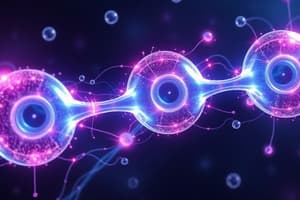Podcast
Questions and Answers
Which of the following Lewis structures are invalid? (Select all that apply)
Which of the following Lewis structures are invalid? (Select all that apply)
- NO3 (correct)
- OF2 (correct)
- CO2 (correct)
- F2 (correct)
What is the Lewis structure for HF?
What is the Lewis structure for HF?
Single bond between H and F; F has three lone pairs.
What is the Lewis structure for H2O?
What is the Lewis structure for H2O?
Single bonds among all three atoms; O has two lone pairs.
What is the Lewis structure for HNO?
What is the Lewis structure for HNO?
Order the following elements by electronegativity from most electronegative to least electronegative.
Order the following elements by electronegativity from most electronegative to least electronegative.
Which molecules cannot be adequately described by a single Lewis structure?
Which molecules cannot be adequately described by a single Lewis structure?
Add formal charges to each resonance form of HCNO. Which structure is favored?
Add formal charges to each resonance form of HCNO. Which structure is favored?
What is the Lewis structure for CO?
What is the Lewis structure for CO?
Assign formal charges to each atom in the resonance forms of SCN-. Which resonance structure contributes the most?
Assign formal charges to each atom in the resonance forms of SCN-. Which resonance structure contributes the most?
Identify the likely identity for X, Y, and Z in the structures provided.
Identify the likely identity for X, Y, and Z in the structures provided.
What are the Lewis structures for SO2 obeying the octet rule?
What are the Lewis structures for SO2 obeying the octet rule?
What is the Lewis structure for ClF2^-1?
What is the Lewis structure for ClF2^-1?
What is the Lewis structure for XeF2?
What is the Lewis structure for XeF2?
What bond is expected to be the most polar?
What bond is expected to be the most polar?
Indicate the direction of polarity of the bonds: C______ - O______
Indicate the direction of polarity of the bonds: C______ - O______
Indicate the direction of polarity of the bonds: O______ - Cl______
Indicate the direction of polarity of the bonds: O______ - Cl______
Indicate the direction of polarity of the bonds: O______ - F______
Indicate the direction of polarity of the bonds: O______ - F______
Indicate the direction of polarity of the bonds: C______ - N______
Indicate the direction of polarity of the bonds: C______ - N______
Indicate the direction of polarity of the bonds: Cl______ - C______
Indicate the direction of polarity of the bonds: Cl______ - C______
Indicate the direction of polarity of the bonds: S______ - H______
Indicate the direction of polarity of the bonds: S______ - H______
Indicate the direction of polarity of the bonds: S______ - Cl______
Indicate the direction of polarity of the bonds: S______ - Cl______
Calculate the percent ionic character of a hypothetical molecule X-Y with a dipole moment of 1.15 D and a bond length of 151 pm.
Calculate the percent ionic character of a hypothetical molecule X-Y with a dipole moment of 1.15 D and a bond length of 151 pm.
Arrange the tripod-shaped molecules in order of decreasing dipole moment.
Arrange the tripod-shaped molecules in order of decreasing dipole moment.
Arrange the bonds from most ionic to most covalent.
Arrange the bonds from most ionic to most covalent.
What are the Lewis formulas for the reactants and products of the hydrogen peroxide formation?
What are the Lewis formulas for the reactants and products of the hydrogen peroxide formation?
Flashcards are hidden until you start studying
Study Notes
Lewis Structures and Resonance
- Lewis structures depict the arrangement of electrons in molecules, highlighting shared and lone pairs.
- Errors in Lewis structures can arise from wrong electron totals or octet-rule violations.
- The nitrate ion (NO₃⁻) has three resonance forms, each involving shifting double bonds and specifying formal charges.
Electronegativity and Bond Polarity
- Electronegativity describes an atom's ability to attract electrons; the order from most to least electronegative: O > N > Al > Na > Rb.
- The bond C-F is expected to be the most polar among various chemical bonds.
- Polar covalent bonds can be marked with delta notation to indicate partial charges.
Formal Charges and Molecular Geometry
- Formal charges help determine the stability of different resonance structures.
- For HCNO, structures can have various formal charges, influencing their favorability.
- Xenon (Xe) can exceed the octet rule, forming stable structures like XeF₂.
Molecular Shapes and Dipole Moments
- Tripod-shaped molecules can be ranked by their dipole moments: NH₃ > PH₃ > AsH₃.
- Percent ionic character quantifies the degree of ionic versus covalent character in a bond, with a formula based on dipole moment.
Free Radicals and Bond Formation
- Free radicals can combine to form stable molecules, such as hydrogen peroxide (H₂O₂), through the formation of new electron-pair bonds.
- Lewis formulas for reactants and products emphasize nonbonding electrons, showcasing the transition from radicals to stable compounds.
Special Compounds and Ions
- Certain molecules, like CO₃²⁻ and ozone (O₃), cannot be represented accurately by a single Lewis structure due to resonance.
- Polyhalide ion ClF₂⁻ contains single bonds, with the central atom (Cl) having three lone pairs, while both fluorine (F) atoms each possess three lone pairs as well.
Summary of Bonding Characteristics
- Arrange bonds according to their ionic character, with K-F being the most ionic and F-F being the most covalent.
- Explore different molecular geometries and varying electron arrangements to better understand chemical bonding and molecular interaction dynamics.
Studying That Suits You
Use AI to generate personalized quizzes and flashcards to suit your learning preferences.




